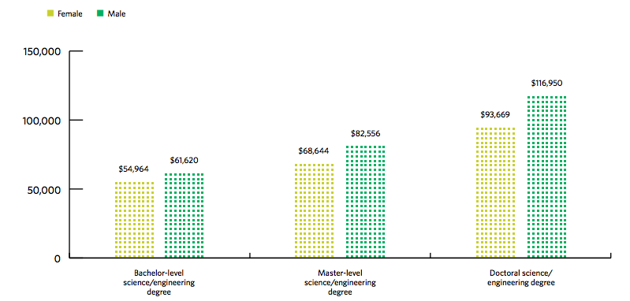The Enduring Sexism in Science
Nobel Laureate Tim Hunt resigned over inappropriate comments, but such blatant instances of bias are only the most publicized examples of a more pervasive problem.
“Let me tell you about my trouble with girls,” the Nobel Laureate Tim Hunt reportedly said on Monday at the World Conference of Science Journalists in South Korea. “Three things happen when they are in the lab: You fall in love with them, they fall in love with you, and when you criticize them they cry.”
Those are the only three things that happen. Romance and tears. What does not happen, apparently, is science.
Following a backlash from conference attendees, on social media, and in regular media, Hunt offered a half-hearted apology on Wednesday, speaking to BBC Radio 4.
“I’m really sorry I said what I said. It was a very stupid thing to do in the presence of all those journalists,” he said. “What was intended is a light-hearted ironic comment. Apparently it was interpreted deadly seriously by my audience.”
Then he added, “I did mean the part about having trouble with girls. It's terribly important that you can criticize people’s ideas without criticizing them and if they burst into tears, it means that you tend to hold back from getting at the absolute truth. Science is about nothing but getting at the truth.”
On Thursday, Hunt, a biochemist, resigned from his faculty position at University College London.
“UCL was the first university in England to admit women students on equal terms to men, and the university believes that this outcome is compatible with our commitment to gender equality,” the university said in a statement.
I guess they weren’t moved by his apology either.
Hunt’s comment is just one in a recent string of highly publicized instances of sexism in the sciences. Add it to the pile along with the column in Science that advised a woman to “put up with” her advisor looking down her shirt, and thepeer-reviewer for PLOS One who suggested two female researchers find a male co-author for their paper.
The thing is, all these examples are pretty egregious, and all were later walked back in some way. Hunt resigned, Science apologized and removed the column, and PLOS One removed the offending reviewer. It would be easy to think that once such blatant offenses are punished, the dragon is slain, so to speak. It would be easy to think these people are outliers.
In so thinking, “we miss the bigger problem and tend to want to scapegoat,” says Heather Metcalf, the director of research and analysis for the Association for Women in Science. Instances like this are part of a bigger systemic problem—“really entrenched biases against women in the sciences that have shifted over time but are still very present,” she says.
In other words, it would be a mistake to listen to the foghorn of Hunt’s comments and ignore the boat it’s signaling.
Women in science, as in so many other fields, are paid significantly less than men on average. In 2008, the median salary for a full-time female scientist or engineer was $24,000 less than for a man. The Scientist’s 2014 Life Sciences Salary Survey found a pay gap that widened with every subsequent science degree earned—from bachelor’s, to master’s, to doctorate.
Average Compensation for U.S. Life Science Professionals, by Gender

While making less money, women scientists also often face harassment. A survey from 2014 found that 70 percent of women scientists had faced sexual harassment while working in the field, and 26 percent had experienced sexual assault. In another study, professors hiring for a lab-manager job judged men to be more competent than women with the same qualifications, and offered them higher salaries.
These are just a handful of the studies showing objective evidence of this gender bias, and while you would think that in the realm of science, data would be the thing to convince people, that doesn’t always seem to be the case. A studyanalyzing the comments left on articles about evidence of sexism in science found that 9.5 percent of comments argued it didn’t exist. Some commenters, mostly men, offered justifications for sexist behavior, and many of those arguments were rooted in biology.
“The way that biases function is that everyone has them,” Metcalf says. “It doesn’t necessarily make you a bad person to have these kinds of biases but they do have real impacts if we don’t become aware of the biases we’re carrying with us. Once we do realize, we have a choice in how we behave. A lot of times these things go unlooked at or unquestioned.”
While over-the-top comments like Hunt’s are often quickly smacked down, Metcalf worries that women could internalize more subtle instances of sexism—being passed over for a promotion, say, or someone questioning a woman scientist’s skills or merit. Someone may wonder if she’s being discriminated against, or if she just really didn’t deserve the promotion.
“We have social beliefs for what it means to be a scientist,” Metcalf says. “We also have those sorts of beliefs surrounding gender. And if we really think about what those expectations are, sometimes we see those conflicting. So there needs to be a lot of work that’s done within scientific culture to challenge and question those roles and expectations.”
When it comes to Hunt, he may well have come of age as a scientist in a time when biases were more explicitly displayed. But “that behavior is coming from something that he’s learned and that has been validated throughout the course of his career,” Metcalf says. When something like this happens, it’s not just a fluke or a leftover from an earlier era that we’ve now transcended. As Metcalf puts it, “The blatant acts and the subtle acts are all coming from the same place.”



